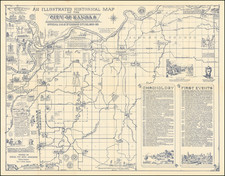Search
George Fuller Green, a notable figure in the architectural and historical tapestry of Kansas City, was born in 1887. His career, distinguished by contributions to both the city’s skyline and its historical record, reflects a deep commitment to Kansas City.
Educated in architecture at the University of Michigan, Green's professional journey began in 1912 with a position as a draftsman under city architect Henry Hoit. Rapidly advancing, he became assistant superintendent of buildings by 1913.
Green's architectural footprint in Kansas City includes prominent projects such as the University Club, the Fort Osage restoration, and Trinity United Methodist Church. His civic service was further demonstrated through his membership on the Kansas City Board of Park Commissioners from 1955 to 1959, contributing to projects like the William Volker Memorial fountain.
Transitioning from architecture, Green devoted his later years to documenting Kansas City's history. At 72, he was named the city’s first historian and curator of the city archives by Mayor H. Roe Bartle. Green approached this role with zeal, often working six days a week without pay, to safeguard the city's historical heritage.
His written work, "A Condensed History of the Kansas City Area" (1968), is a significant addition to the city’s historiography. This book also serves as a tribute to his late son, Lieutenant John J. Green II. Green's family history is closely linked to Kansas City, with his father, John J. Green, serving on the City Council in the late 19th century.
Green, along with historian James Anderson, led the research and reconstruction efforts for Fort Osage, culminating in its designation as a National Historic Landmark in 1961.
The Missouri State Historical Society maintains the George Fuller Green and James Anderson Photograph Collection, evidencing his historical work. Additionally, the Kansas City Museum holds Green's archives on the history of Kansas City. Green engaged in civic activities beyond architecture and history, such as his involvement with the Commission of International Relations and Trade in Kansas City. His presidencies of the Native Sons of Kansas City and the Kansas City Museum association further reflect his dedication to the city's cultural and historical preservation.

